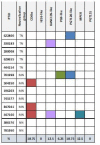Distinct clonal evolution of B-cells in HIV controllers with neutralizing antibody breadth
- PMID: 33843586
- PMCID: PMC8041465
- DOI: 10.7554/eLife.62648
Distinct clonal evolution of B-cells in HIV controllers with neutralizing antibody breadth
Abstract
A minor subset of individuals infected with HIV-1 develop antibody neutralization breadth during the natural course of the infection, often linked to chronic, high-level viremia. Despite significant efforts, vaccination strategies have been unable to induce similar neutralization breadth and the mechanisms underlying neutralizing antibody induction remain largely elusive. Broadly neutralizing antibody responses can also be found in individuals who control HIV to low and even undetectable plasma levels in the absence of antiretroviral therapy, suggesting that high antigen exposure is not a strict requirement for neutralization breadth. We therefore performed an analysis of paired heavy and light chain B-cell receptor (BCR) repertoires in 12,591 HIV-1 envelope-specific single memory B-cells to determine alterations in the BCR immunoglobulin gene repertoire and B-cell clonal expansions that associate with neutralizing antibody breadth in 22 HIV controllers. We found that the frequency of genomic mutations in IGHV and IGLV was directly correlated with serum neutralization breadth. The repertoire of the most mutated antibodies was dominated by a small number of large clones with evolutionary signatures suggesting that these clones had reached peak affinity maturation. These data demonstrate that even in the setting of low plasma HIV antigenemia, similar to what a vaccine can potentially achieve, BCR selection for extended somatic hypermutation and clonal evolution can occur in some individuals suggesting that host-specific factors might be involved that could be targeted with future vaccine strategies.
Keywords: BCR repertoire; HIV infection; b-cell evolution; cell biology; human; infectious disease; microbiology; neutralizing antibodies.
© 2021, Cizmeci et al.
Conflict of interest statement
DC, GL, ER, AD, MS, BJ No competing interests declared, DK, GC, NN employee of Atreca Inc, YT Former employee of Atreca Inc Now employee of Esco Ventures X. GA GA is a founder of Seromyx Systems.
Figures







Similar articles
-
Aberrant B cell repertoire selection associated with HIV neutralizing antibody breadth.Nat Immunol. 2020 Feb;21(2):199-209. doi: 10.1038/s41590-019-0581-0. Epub 2020 Jan 20. Nat Immunol. 2020. PMID: 31959979 Free PMC article.
-
Rapid Induction of Multifunctional Antibodies in Rabbits and Macaques by Clade C HIV-1 CAP257 Envelopes Circulating During Epitope-Specific Neutralization Breadth Development.Front Immunol. 2020 Jun 2;11:984. doi: 10.3389/fimmu.2020.00984. eCollection 2020. Front Immunol. 2020. PMID: 32582155 Free PMC article.
-
Increased breadth of HIV-1 neutralization achieved by diverse antibody clones each with limited neutralization breadth.PLoS One. 2018 Dec 19;13(12):e0209437. doi: 10.1371/journal.pone.0209437. eCollection 2018. PLoS One. 2018. PMID: 30566528 Free PMC article.
-
Broadly Neutralizing Antibodies against HIV: Back to Blood.Trends Mol Med. 2019 Mar;25(3):228-240. doi: 10.1016/j.molmed.2019.01.007. Epub 2019 Feb 18. Trends Mol Med. 2019. PMID: 30792120 Free PMC article. Review.
-
Genetic and structural analyses of affinity maturation in the humoral response to HIV-1.Immunol Rev. 2017 Jan;275(1):129-144. doi: 10.1111/imr.12513. Immunol Rev. 2017. PMID: 28133793 Free PMC article. Review.
Cited by
-
Human B cell lineages associated with germinal centers following influenza vaccination are measurably evolving.Elife. 2021 Nov 17;10:e70873. doi: 10.7554/eLife.70873. Elife. 2021. PMID: 34787567 Free PMC article.
-
ViCloD, an interactive web tool for visualizing B cell repertoires and analyzing intraclonal diversities: application to human B-cell tumors.NAR Genom Bioinform. 2023 Jun 28;5(2):lqad064. doi: 10.1093/nargab/lqad064. eCollection 2023 Jun. NAR Genom Bioinform. 2023. PMID: 37388820 Free PMC article.
-
B cell phylogenetics in the single cell era.Trends Immunol. 2024 Jan;45(1):62-74. doi: 10.1016/j.it.2023.11.004. Epub 2023 Dec 27. Trends Immunol. 2024. PMID: 38151443 Free PMC article. Review.
-
Dynamics and durability of HIV-1 neutralization are determined by viral replication.Nat Med. 2023 Nov;29(11):2763-2774. doi: 10.1038/s41591-023-02582-3. Epub 2023 Nov 13. Nat Med. 2023. PMID: 37957379 Free PMC article.
-
Enhanced HIV-1 Neutralizing Antibody Breadth in HTLV-2 Co-Infected Individuals: Influence of Antiretroviral Regimen and B Cell Subset Distribution.Vaccines (Basel). 2025 Jun 13;13(6):639. doi: 10.3390/vaccines13060639. Vaccines (Basel). 2025. PMID: 40573970 Free PMC article.
References
-
- CAPRISA002 Study Team. Gray ES, Madiga MC, Hermanus T, Moore PL, Wibmer CK, Tumba NL, Werner L, Mlisana K, Sibeko S, Williamson C, Abdool Karim SS, Morris L. The neutralization breadth of HIV-1 develops incrementally over four years and is associated with CD4+ T cell decline and high viral load during acute infection. Journal of Virology. 2011;85:4828–4840. doi: 10.1128/JVI.00198-11. - DOI - PMC - PubMed
Publication types
MeSH terms
Substances
Grants and funding
LinkOut - more resources
Full Text Sources
Other Literature Sources
Medical

